The duck is a particularly useful bird since it may be used for its meat, eggs, and feathers.
Choosing the right breed of duck is important if you want to breed them on your farm. While we choose some duck breeds for their tasty meat, others are chosen for their eggs. A duck’s laying cycle is not seasonal.
Ducks, unlike chickens, lay eggs all year because they require less light to survive and are not affected by the gloomy, damp days of fall and winter.
Compared to chickens, ducks are prolific egg layers. Ducks can lay between 300 and 350 eggs annually, compared to 250 eggs laid by chickens.
If you’re interested in raising ducks for their eggs but need help deciding which type to choose, read on to find out more!
10 Best Duck Breeds for Eggs
| Breed | Egg Production per Year |
| Indian Runner | 200-350 |
| Khaki Campbell | 200-340 |
| Welsh Harlequin | 240-330 |
| American Pekin | 200-300 |
| Magpie | 220-280 |
| Golden 300 Hybrid Layer | 200-290 |
| Silver Appleyard | 120-270 |
| Buff Orpington | 150-220 |
| Ancona | 200 |
| Saxony | 200 |
Table of Contents
1. Indian Runner
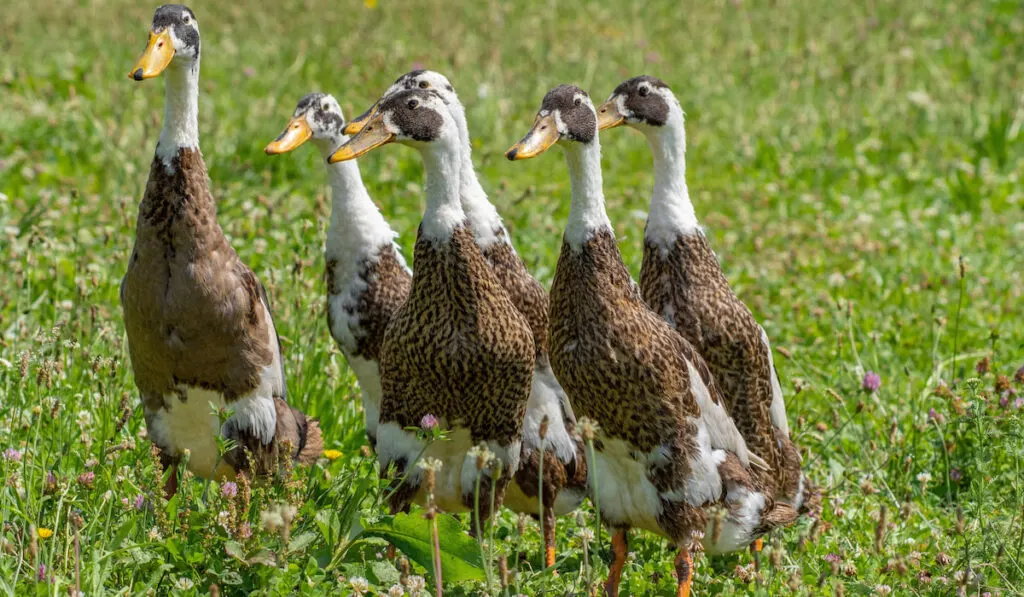
Indian Runner Ducks were first discovered in Indonesia and introduced to Europe in the nineteenth century. They arrived in the early 1900s and rapidly gained popularity among American duck lovers.
Both the eggs and the meat of Indian Runner ducks are delicious. Females can lay anything from 200 to 350 eggs every year.
The meat from Indian Runner Ducks is excellent quality, too. Despite their status as a “light” bird, they make for fabulous dining thanks to their high meat-to-bone ratio.
When threatened or defending their young, they can be aggressive, but the Indian Runner Duck is known to be a calm and peaceful bird. As a result, they are lovely pets, and they get along fine with most other pets.
These beautiful ducks are commonly included in exhibitions and shows. Among the colors available are white, black, brown, and silver.
Indian Runner Ducks are relatively easy to keep. These ducks need an enclosure with a pond and a place to hide and sleep.
Indian Runner – Key Information:
- Egg Production per year: 200-350
- Egg Size: 2.3-2.8 oz. (65-80 grams)
- Uses: meat, eggs
- Temperament: calm and gentle
- Bird Weight: Hen 3-4 lbs; Drake 3-5 lbs
- Care Level: easy
- Origin: Indonesia
- Color: white, black, brown, and silver
2. Khaki Campbell
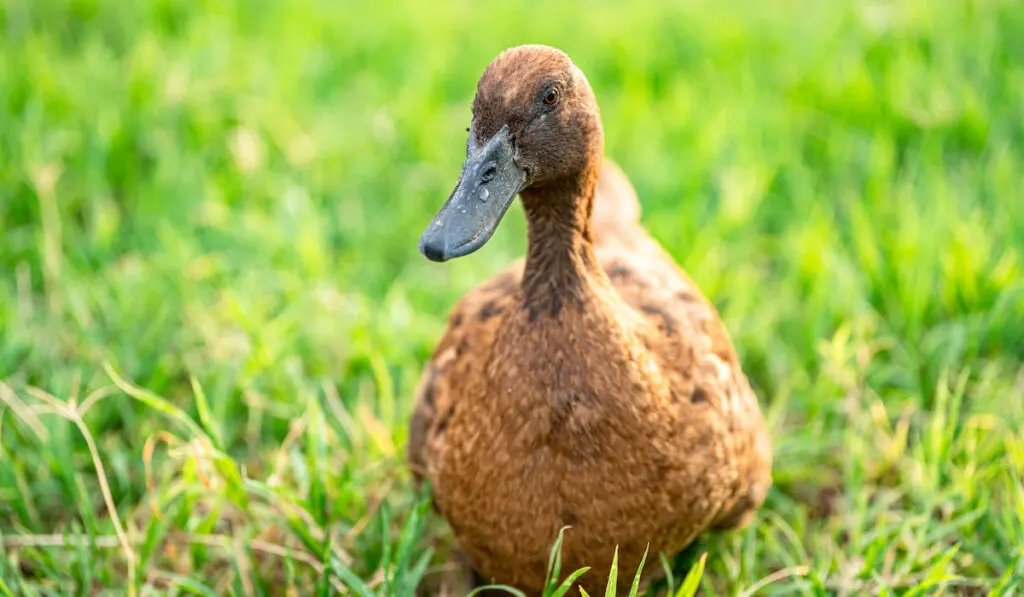
The Khaki Campbell domestic duck was developed in England in the nineteenth century. Over the years, the English-born Khaki Campbell has become a household name worldwide thanks to its exceptional qualities.
Khaki Campbells have a reputation for being tame and human friendly. They are low-maintenance and don’t need a lot of room. Like any other kind of duck, they can make quite a noise when they become excited.
When it comes to laying eggs, Khaki Campbells are unrivaled! A hen’s yearly egg production can reach 340 big, brown eggs!
Ducks of the Khaki Campbell species are considered medium size, with males weighing about 6 pounds and females about 5 pounds.
Their characteristic plumage is a light brown tint with dark streaks running through it. The eyes of a Khaki Campbell are dark brown, and its bill and feet are orange.
Khaki Campbells, as a breed, tend to be subdued and tame. They are great as companion animals in groups or on their own. Khaki Campbells are a great option for backyard farmers looking for a hardy, productive duck.
Khaki Campbell – Key Information:
- Egg Production per year: 200-340
- Egg Size: 2.6-3 oz. (75-85 grams)
- Uses: eggs, meat, pet
- Temperament: intelligent and docile, and they bond well with humans
- Bird Weight: Hen 4.5 lbs; Drake 5-5.5 lbs
- Care Level: easy
- Origin: England
- Color: khaki
3. Welsh Harlequin
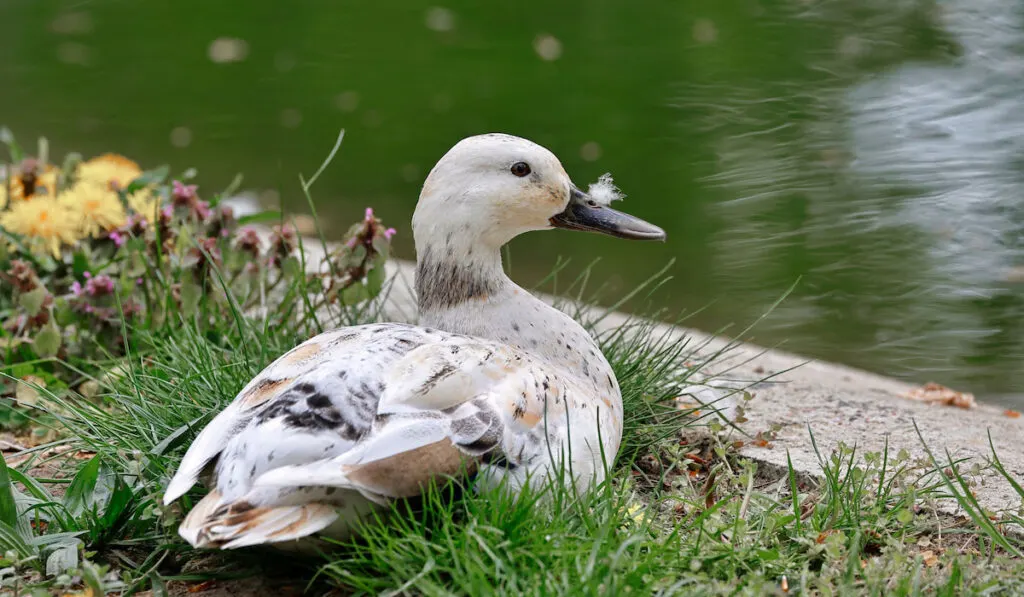
The Welsh Harlequin is an excellent option if you want a beautiful duck that produces eggs like a Campbell.
A modification in Khaki Campbell ducklings led to the creation of this breed. Though they originated in Wales, these stunning ducks have been a staple in the United States for decades!
The Welsh Harlequin is about as good as it gets in terms of duck eggs.
Females can produce as many as 330 eggs per year, making these ducks more productive than chickens.
Although they are great for eating, the meat from these ducks will be smaller because of their low body weight (often less than 5.5 pounds). Even though they are small, their meat is excellent if appropriately raised.
These ducks make ideal pets or ornamental birds due to their lovely pale plumage and peaceful temperaments. They are gradually becoming a popular breed due to their versatility. They are calm, intelligent, and excellent foragers.
Due to their low maintenance requirements, resilience, and pleasant demeanor, Welsh Harlequins are an excellent choice for hobby farms. These are the best ducks to get if you’re a backyard farmer or a newcomer to duck-raising.
Welsh Harlequin – Key Information:
- Egg Production per year: 240-330
- Egg Size: 2.6-3.2 oz. (75-90 grams)
- Uses: meat, eggs
- Temperament: One of the quieter duck breeds. Docile and active.
- Bird Weight: Hen 5-5.5 lbs; Drake 5.5-6.5 lbs
- Care Level: easy
- Origin: Wales
- Color: white, tinted, gold or silver
4. American Pekin
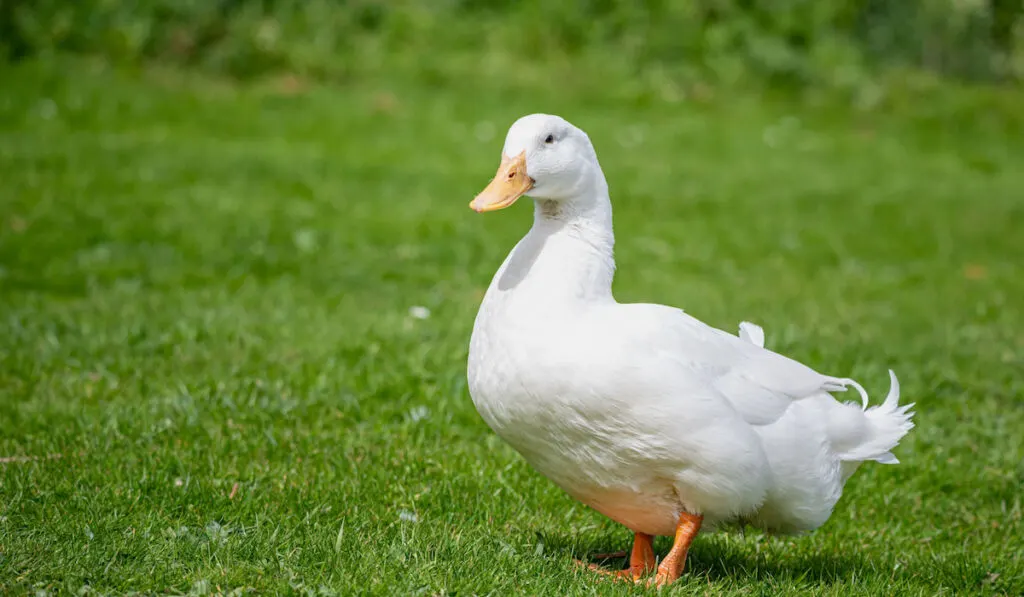
The Pekin Duck, sometimes known as the American Pekin, is one of the most common domestic ducks in the United States. The American Pekin duck is a large, white bird with a sturdy build.
These ducks are a multipurpose breed for both egg and meat production. White-feathered ducks are also easier to pluck and clean.
American Pekin duck meat contains a lot of protein and tastes great.
Hens usually start laying eggs between 5 and 6 months of age, when they lay 200 to 300 extra-large white eggs.
They need 8 to 10 hours of light a day to lay eggs, so in the winter, they will need light in their coop.
This duck breed excels in free-range systems. They may forage for the majority of their food while being vigilant for any predators and hurrying back to their coop for safety if needed.
Their affectionate and docile nature has led to many people keeping them as pets rather than livestock; they are well-known for being social and intelligent birds.
Pekin ducks make great pets or poultry on small farms. They can live peacefully with chickens in a coop or freely graze on the farm.
American Pekin – Key Information:
- Egg Production per year: 200-300
- Egg Size: 3.17-3.5 oz. (90-100 grams)
- Uses: excellent egg layers, substantial amounts of tasty meat
- Temperament: friendly and intelligent birds
- Bird Weight: Hen 9 lbs; Drake 10 lbs
- Care Level: easy, thrive in almost any environment
- Origin: China
- Color: white
5. Magpie
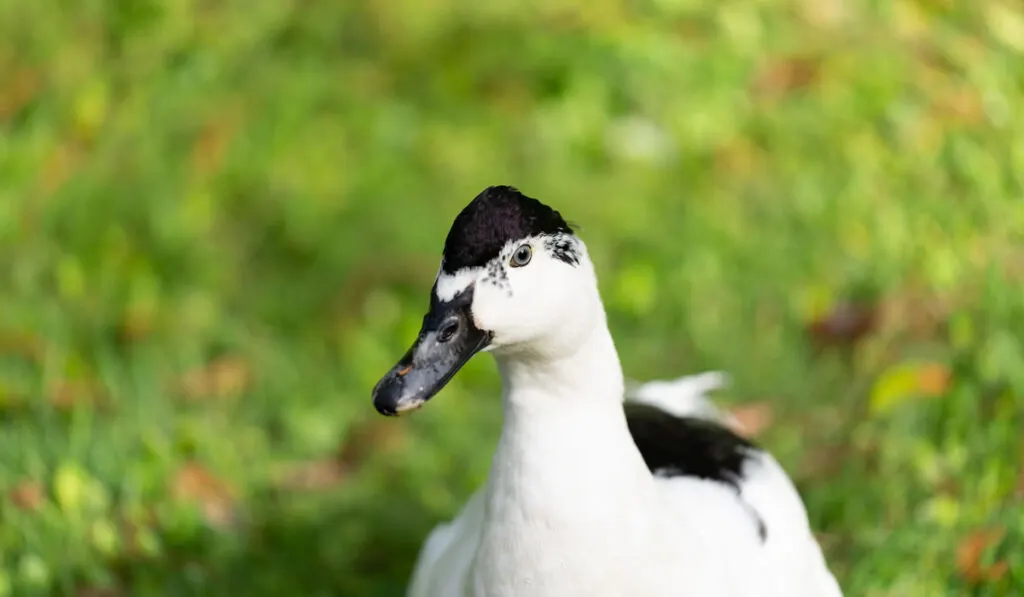
Despite having its roots in Wales, the Magpie duck is more widely known and appreciated in the United States.
The Magpie duck is easily identifiable by its small size and striking black-and-white plumage. Domesticated and raised for their eggs, meat, and feathers, as well as keeping them as pets, this duck breed is exceptionally resilient and adaptable.
Due to their robustness and lack of serious health problems, Magpies are popular among duck owners.
They are a good breed to keep for the egg trade due to their ability to produce large numbers of eggs (from 220 to 280 per year).
Meat from Magpie ducks is of great quality, with a nice flavor and soft texture; yet many duck enthusiasts find it difficult to keep these ducks for their meat once they’ve had the pleasure of caring for them. They prefer them as pets rather than as meat sources.
Magpie ducks are popular pets because of their many desirable traits. You won’t have to worry about this breed of duck flying away because it can’t fly.
Many people who keep ducks choose Magpie ducks because they are hardy and can thrive in many different conditions. They were originally raised in Wales, where all four seasons can be harsh.
You can keep these ducks alone or in small or large groups, and if you give them the proper care and conditions, they will breed well and provide you with companionship, meat, or eggs.
Magpie – Key Information:
- Egg Production per year: 220-280
- Egg Size: 2.3-2.5 oz. (65-72 grams)
- Uses: Meat, eggs, pets
- Temperament: friendly and active
- Bird Weight: Hen 4.5 lbs; Drake 5 lbs
- Care Level: easy
- Origin: Wales
- Color: white, black, blue
6. Golden 300 Hybrid Layer
The Golden 300 is a type of hybrid duck. These ducks are a cross of the Cayuga, Rouen, Campbell, and Runner breeds and are outstanding egg layers.
Each duck may have a distinct appearance due to its inherited genes, but males are generally shades of black, while females are generally shades of brown.
This duck weighs between 4.5 and 5.75 pounds, and every year it lays between 200 and 290 large, mostly white eggs that weigh between 2.6 and 3.2 ounces. About 5% of the eggs may have a blue-green hue.
Usually, they also have great personalities, which makes them good pets.
As far as their overall health goes, they are very healthy ducks if you take care of them properly.
Golden 300 Hybrid Layer – Key Information:
- Egg Production per year: 200-290
- Egg Size: 2.6-3.2 oz. (75-90 grams)
- Uses: outstanding egg layers
- Temperament: variable
- Bird Weight: Hen 4.5 lbs; Drake 5.75 lbs
- Care Level: easy
- Origin: USA
- Color: very light brown to a very dark brown
7. Silver Appleyard
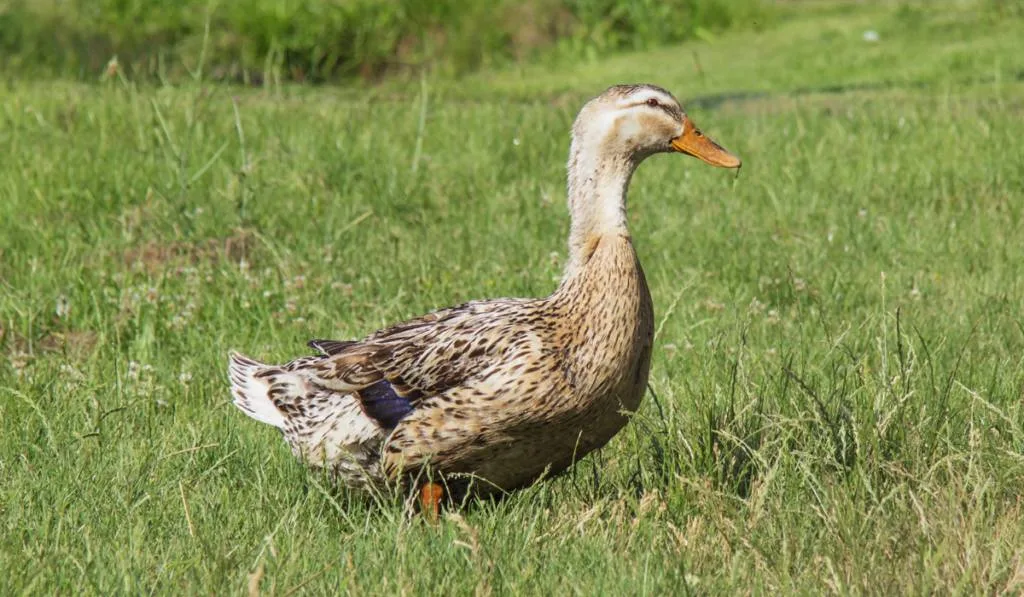
The Silver Appleyard is a domestic duck breed that originated in the United Kingdom. Reginald Appleyard developed them in the first half of the 20th century so that they could produce both meat and a lot of eggs.
Both males and females have blue-green-violet coloring, intensifying and brightening with time. The female has an orange beak, while the male’s beak is more green.
The Silver Appleyard ducks are productive, cheerful, and hardy, but it is also worth noting that they tend to be fairly loud.
Silver Appleyard ducks lay a high number of eggs annually (100–270) and provide high-quality, low-fat meat.
These ducks are social creatures that need to be with others of their kind in order to thrive.
Silver Appleyard – Key Information:
- Egg Production per year: 100-270
- Egg Size: 2.2-2.9 oz. (60-85 grams)
- Uses: eggs, meat
- Temperament: friendly and cheerful
- Bird Weight: Hen 7-8 lbs; Drake 8-10 lbs
- Care Level: easy
- Origin: England
- Color: Blue-green-violet, brown and white coloring
8. Buff Orpington
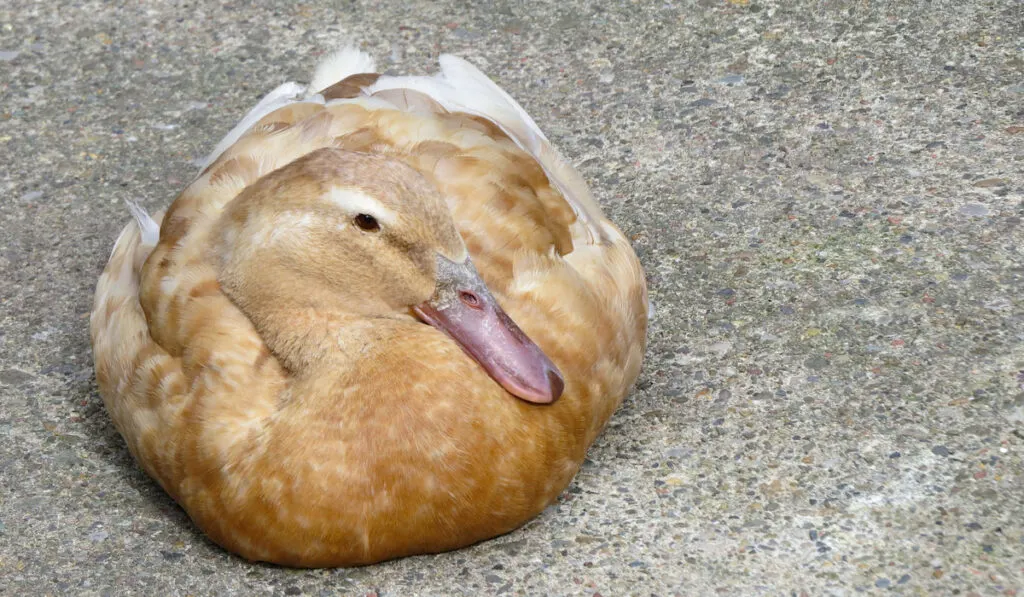
Buff Orpington ducks are a modern domestic success story. The Orpington was bred in the United Kingdom in the early 20th century for egg production and meat.
Light brown feathers set Buffs apart from other birds. Darker feathers sometimes surround the male’s head and neck, and white patches can be found on either sex.
As a result of their high egg production, Buff Orpingtons are a popular choice for those who want to raise ducks for eggs. The average Buff hen will produce between 150 and 220 eggs each year.
Their robustness and quick development also make them suitable as meat birds.
Compared to other duck breeds, Buff Orpingtons are quite small and light and are classified as “light-class poultry.” The average weight of a hen is around 6 pounds, whereas the average weight of a drake is about 6.5 to 8 pounds.
As with other types of domesticated ducks, Buff Orpingtons cannot fly.
Buff Orpington – Key Information:
- Egg Production per year: 150-220
- Egg Size: 2.8-3.2 oz. (80-90 grams)
- Uses: eggs, meat
- Temperament: friendly and sociable
- Bird Weight: Hen 5-6 lbs; Drake 6.5-8 lbs
- Care Level: easy
- Origin: England
- Color: light brown, dark brown and white
9. Ancona
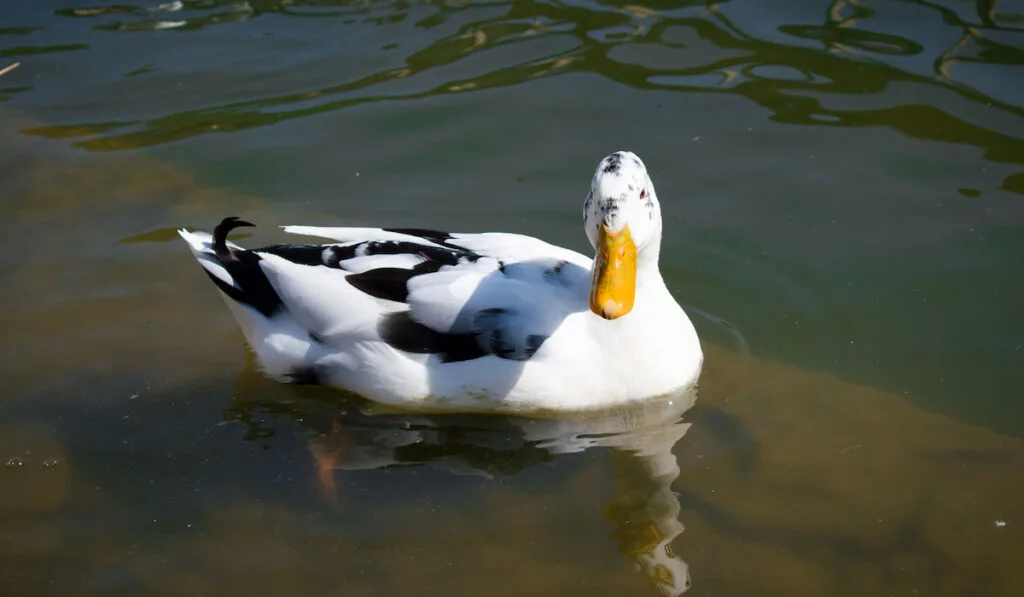
The Ancona duck was once thought to have come from Britain, but recent studies have shown that it originated in the United States. Across the United States, farmers and hobbyist breeders are now actively farming this species.
These ducks are calm and friendly. In most cases, it is safe to let them roam free because they stick close to their home territory. They are sociable and may coexist peacefully with other friendly, gentle duck species.
The primary reason people keep Ancona ducks is for their eggs. The average female may lay about 200 eggs yearly, making them highly productive egg layers.
A fully grown Ancona duck weighs between 6 and 7 pounds. Feathers can be either black, white, or silver. This breed can be any shade of color so long as white is present.
Ancona – Key Information:
- Egg Production per year: 200
- Egg Size: 2.5 oz. (70 grams)
- Uses: eggs, meat
- Temperament: active, friendly
- Bird Weight: Hen 5-6 lbs; Drake 6-7 lbs
- Care Level: easy
- Origin: USA
- Color: chocolate and white, black and white, silver and white, tricolored
10. Saxony
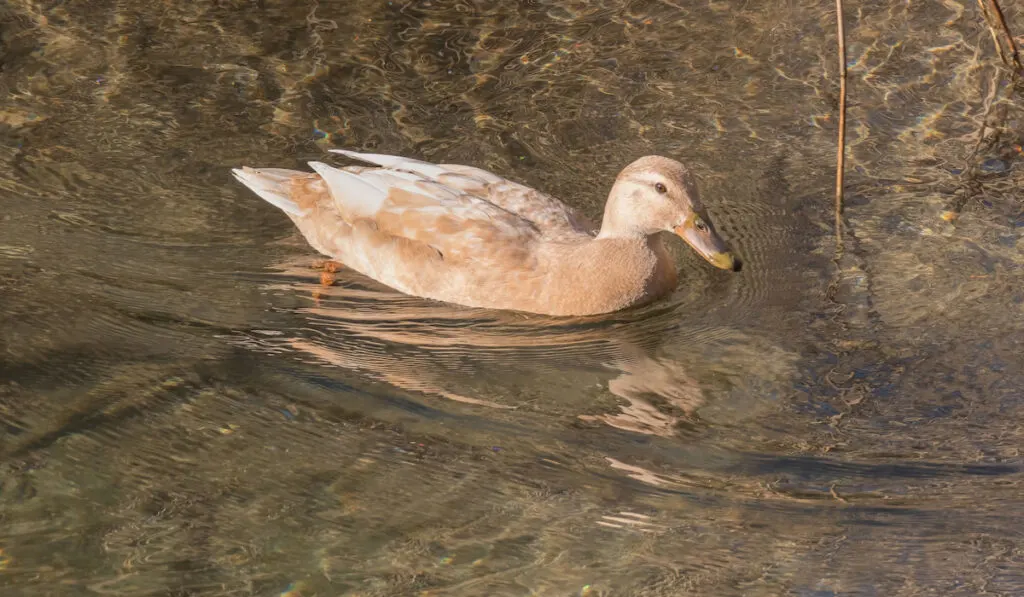
The first domesticated Saxony ducks were bred in Germany in the 1930s. The Saxony duck is a large breed that is valued for both its flesh and its eggs.
The Saxony duck is a versatile breed often regarded as one of the top-heavy all-purpose ducks available today.
As a good layer, a Saxony can lay up to 200 large white eggs annually. They mature rapidly, have more flavorful meat with less fat, and grow to full size swiftly.
Therefore, the breed is perfect for the meat industry.
Keeping Saxony ducks in pens is easy because they are unable to fly. These ducks have calm temperaments and are safe to keep around domestic pets. However, the females can be pretty noisy at times.
Saxony – Key Information:
- Egg Production per year: 200
- Egg Size: 2.8 oz. (80 grams)
- Uses: eggs, meat
- Temperament: Tame, foraging
- Bird Weight: Hen 8 lbs; Drake10 lbs
- Care Level: easy
- Origin: Germany
- Color: orange or reddish brown and white
Which Duck Is Best for Eggs?
For maximum egg production, Indian Runner Ducks are your best bet, but Khaki Campbell and Welsh Harlequins are not far behind.
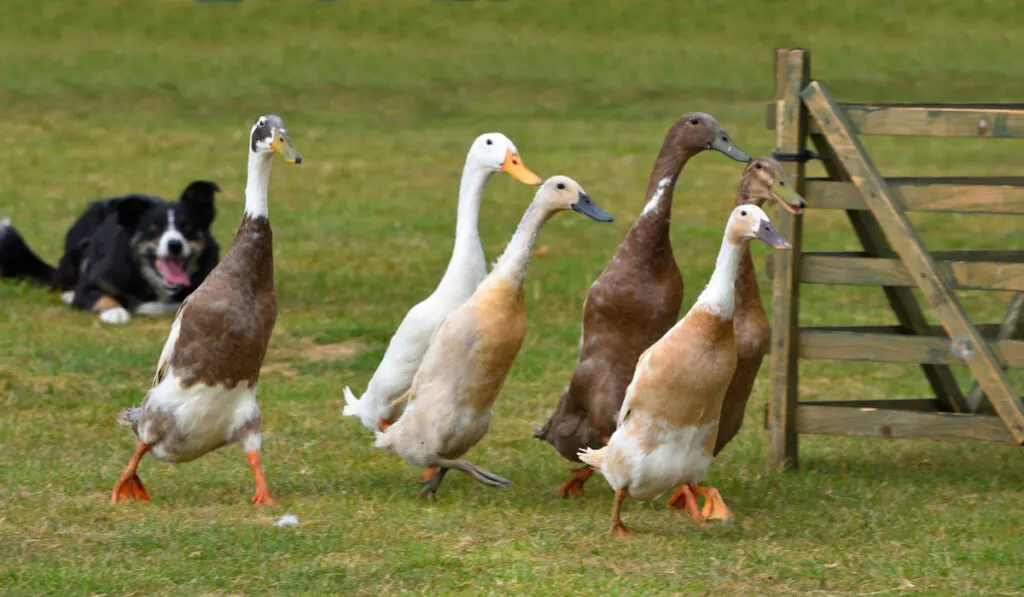
Do All Ducks Lay Edible Eggs?
You may have wondered if all duck eggs are edible. You have nothing to worry about. All ducks lay edible eggs. Duck eggs also offer higher levels of Omega-3, vitamins A and D, fatty acids, choline, folic acid, and iron than chicken eggs.
Final Thoughts
Raising ducks is a useful and enjoyable hobby. Ducks lay more eggs yearly than hens, and each egg is much larger.
Compared to chicken hens, duck hens are the most sustainable small livestock to handle on a farm due to their ability to continue laying eggs far into their sixth or ninth year of life.
Ducks are also very smart and friendly, which makes them great candidates for the role of a family pet.
Resources
- https://poultry.extension.org/articles/feeds-and-feeding-of-poultry/feeding-ducks-for-egg-production-kept-in-small-flocks/
- https://www.dpi.nsw.gov.au/animals-and-livestock/poultry-and-birds/species/duck-raising/egg-production
- https://www.metzerfarms.com/compare-duck-breeds.html
- https://runnerduck.net/history.php;
- https://backyardpoultry.iamcountryside.com/poultry-101/indian-runner-duck-breed-profile/;
- https://petkeen.com/indian-runner-duck/;
- https://www.omlet.co.uk/breeds/ducks/campbells/;
- https://www.metzerfarms.com/khaki-campbell-ducks.html;
- https://livestockconservancy.org/heritage-breeds/heritage-breeds-list/khaki-campbell-duck/;
- https://www.chickensandmore.com/khaki-campbell-duck/
- https://livestockconservancy.org/heritage-breeds/heritage-breeds-list/welsh-harlequin-duck/
- https://www.roysfarm.com/pekin-duck/;
- https://learnpoultry.com/pekin-duck/;
- https://www.chickensandmore.com/pekin-duck/
- https://www.metzerfarms.com/magpies.html;
- https://livestockconservancy.org/heritage-breeds/heritage-breeds-list/magpie-duck/;
- https://petkeen.com/magpie-duck/
- https://www.metzerfarms.com/golden-300-hybrid-layer-ducks.html;
- https://www.metzerfarms.com/blog/golden-300-and-white-layer-ducks.html
- https://backyardpoultry.iamcountryside.com/poultry-101/silver-appleyard-duck-breed-spotlight/;
- https://www.thehappychickencoop.com/silver-appleyard/
- https://livestockconservancy.org/heritage-breeds/heritage-breeds-list/buff-orpington-duck/;
- https://fowlguide.com/buff-orpington-ducks/
- https://livestockconservancy.org/heritage-breeds/heritage-breeds-list/ancona-duck/;
- https://fowlguide.com/ancona-ducks/
- https://livestockconservancy.org/heritage-breeds/heritage-breeds-list/saxony-duck/;
- https://www.metzerfarms.com/saxony-ducks.html;
- https://www.roysfarm.com/saxony-duck/;
- https://petkeen.com/saxony-duck/
